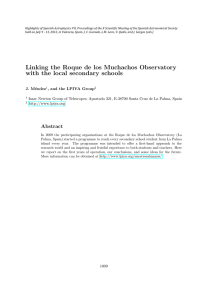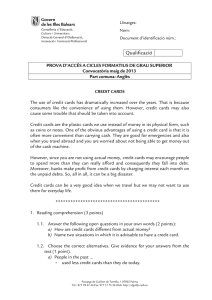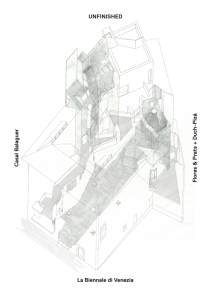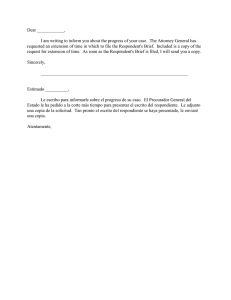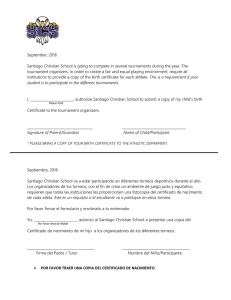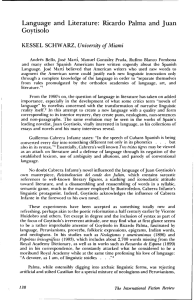El Tajin, Veracruz, Gulf Coast of Mexico Palma of ballplayer
Anuncio
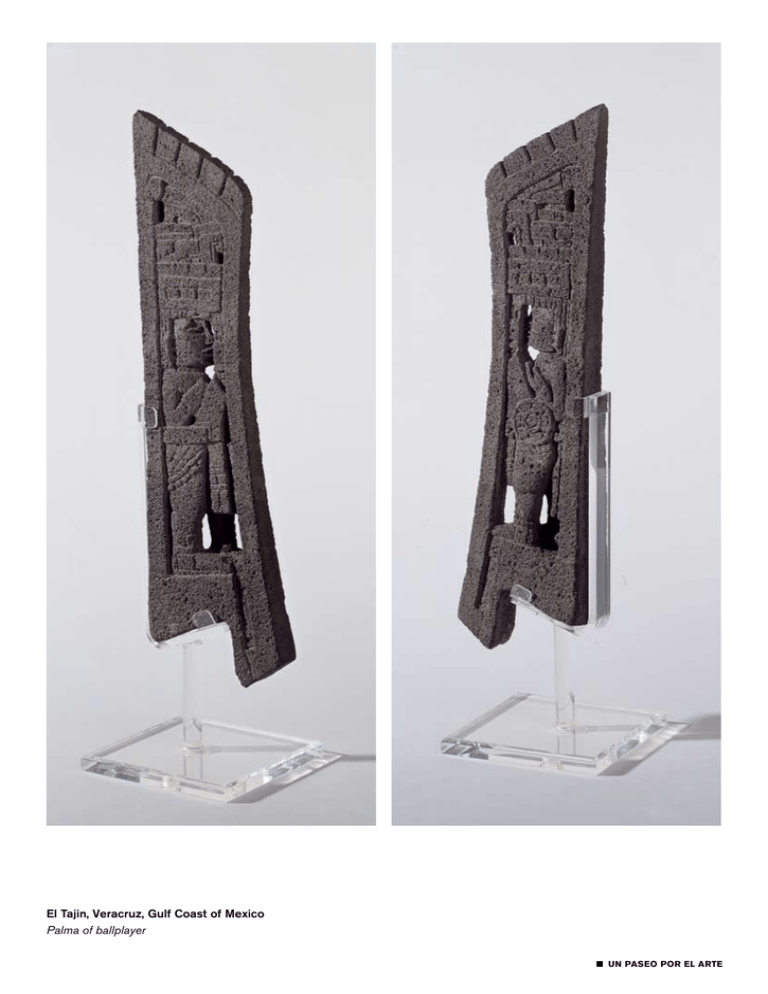
El Tajin, Veracruz, Gulf Coast of Mexico Palma of ballplayer un paseo por el arte El Tajin, Veracruz, Gulf Coast of Mexico Late Classic, AD 600–900 Palma of ballplayer stone 72.0 x 17.6 x 7.8 cm Purchased through The Art Foundation of Victoria with the assistance of the Westpac Banking Corporation, Founder Benefactor, 1983 (PC15-1983) The stone sculpture of Veracruz, hard-bitten and austere, focused on the ceremonial ball game, from which it drew its characteristic iconography. The term palma (or palmate stone) designates a tall, fan-shaped sculpture with an angular base. The base of this slender example has been cut enabling it to be placed upon the curved front of a U-shaped yoke, also of stone. This palma is exceptional because the low relief carving on each side portrays a ballplayer in profile wearing a yoke upon which rests a palma: the design itself explicates the function of the palma as a ritual object of the ballgame cult. The player stands within a raised border frame that curves diagonally upward terminating in a scroll. Along the upper edge, five rectangles represent the customary feather crest. The contour of the player’s face is heightened by openwork carving which also leaves an open space in front of the lower leg. His processional pose and impassive facial expression perhaps hint at some of the sinister aspects of the ball-game cult: it served as a public re-enactment of warfare and incorporated human sacrifice. In some instances, victorious ballplayers decapitated the defeated ones; skull racks for the trophies often adjoin ball courts. The player is dressed in fringed hip-cloth with cross-hatching, sandals with heel guards, jade bracelet and jade ear discs worn by persons of rank. His rectangular belt indicates the stone yoke: the palma upon it has the same angular base, although in this case yoke and palma are undecorated. His right hand is covered by a protective glove; while his left hand is raised above a large circular device, customarily worn at the back. In front of the legs hangs the flap of the loincloth, which is also decorated with geometric designs. His tall headdress is incised with three angular roundels in a frame, an attribute commonly found on Teotihuacan rain god images. Above the rectangle is a conventionalised serpent head with a backward curved scroll behind the reptile’s eye. A taller scroll represents the nose: from it rise two feathers that are bent back. The ancient Veracruz sculptor portrayed the essential attributes of a dignitary participating in a ball game ritual with great clarity and simplicity, choosing to stress angularity in the designs and to eschew the elaborately curved scrollwork, which is a hallmark of Classic Veracruz art. Judith Ryan El Tajín, Veracruz, Costa del Golfo de México Clásico tardío, 600-900 a.C. Palma con jugador de pelota Piedra Adquirida a través de la Art Foundation of Victoria con la ayuda de Westpac Banking Corporation, Fundador y Benefactor, 1983 (PC15-1983) La escultura de piedra de Veracruz, dura y austera, refleja el juego de pelota ceremonial, en el que se inspira su particular y característica iconografía. El término palma (o piedra palmada) designa una escultura alta, en forma de abanico sobre una base angular. La base de este esbelto ejemplo ha sido cortada para colocarla encima de un yugo en forma de U, también de piedra. Esta palma es verdaderamente excepcional. Por ambos lados, en bajorrelieve, figura un jugador de pelota de perfil llevando un yugo sobre el que se apoya una palma. El diseño mismo explica la función de la palma como objeto ritual en el culto del juego de pelota. El jugador está de pie dentro de un marco sobresaliente de curva diagonalmente ascendente que termina formando una espiral. En el borde superior, cinco rectángulos representan el habitual penacho de plumas. El contorno de la cara del jugador se acentúa bordeándola con calados y también se deja un espacio abierto en la parte de delante de las piernas. Su postura procesional y rostro impasible insinúan quizás alguno de los aspectos siniestros del juego de pelota: representación pública de las guerras y de los sacrificios humanos. En algunas ocasiones, los jugadores victoriosos decapitaban a los vencidos, y al lado de los campos de juego había estanterías para exhibir las calaveras. El jugador lleva un faldellín a cuadros y orlado que le llega a la rodilla, sandalias cerradas por detrás para proteger el talón, brazalete y discos de jade en la orejas, como los usados por las personas de alto rango. Su cinturón rectangular lleva el yugo de piedra; la palma de encima tiene también la base angular, pero, en este caso, ni la palma ni el yugo están decorados. Un guante le protege la mano derecha; la izquierda sobresale por encima de un artefacto circular, habitualmente llevado a la espalda. Delante de las piernas cuelga el pliegue del taparrabos decorado con dibujos geométricos. Su alto tocado lleva incrustados tres roeles angulares dentro de un marco rectangular, atributo que aparece en las imágenes del dios de la lluvia en Teotihuacan. Por encima del rectángulo hay una cabeza de serpiente con una espiral detrás de los ojos. Una espiral más alto del que salen dos plumas dobladas hacia atrás representa la nariz. El escultor de la antigua Veracruz reflejó los atributos esenciales de un dignatario participando en el ritual de juego de pelota con gran claridad y sencillez, escogiendo diseños angulares y evitando el elaborado trabajo de espirales, típico del arte clásico de Veracruz. Thinking and discussing before the visit • Discuss what role sport plays in our society? What role did it play in past civilizations? • Compare sports from ancient civilizations with those of today. In each case, consider their purpose and social or religious value. How have modern lifestyles and new technologies affected sport today? • Research the MCG (Melbourne Cricket Ground), a major sports venue in Melbourne today, and the Colosseum, which was built nearly two thousand years ago in Ancient Rome. » In what ways are they similar and different? Consider the function of each, the building materials and techniques used, numbers of spectators accommodated, entry and exit strategies and sports played within. • What human values might be developed though playing and watching sport? Create an illustrated diagram or chart explaining your ideas. • Discuss whether there are instances where sport can have unfavourable effects on society. • Research what sports are most popular in Spain and South America today. Why might this be? Gallery visit activities The ancient ball game of Mesoamerica was a fundamental part of the life and ritual of the diverse cultures that existed there before the arrival of the Spanish. It is believed to have originated in the Gulf Coast of Mexico over two thousand years ago. Evidence suggests that the object of the game was to project a rubber ball into the opposing team’s end of the court or through a ring or marker on the side of the court. Research the ancient ball game of Mesoamerica. Find out about the religious and cultural beliefs associated with the game, the purpose of the game, the number of players and the clothes they wore, the material used to make the ball and the location and structure of the ball courts. Useful links www.ballgame.org • What is the palma made of? How does the material contribute to the mood of the sculpture? • What sort of tools might the sculptor have used? • Look carefully at the palma. Describe the figure carved on it. • What patterns and shapes has the sculptor used to decorate the clothes and headdress of the player? • Why might the sculptor have carved the player in profile view? • What clues may suggest that the player is a man of high rank in society? What evidence is there to suggest that the ballgame was dangerous? • Why might the sculptor have carved through the stone in some places to reveal areas of light? • What do the facial expression and pose of the player suggest about the nature of the game? • Find the serpent on the sculpture? What might it signify? Discuss the symbolism of serpents in other cultures. • Why might the sculptor have wanted to capture the essence of the ballgame in a sculpture? un paseo por el arte Post- visit activities • Discuss what art and sport might have in common. Why might artists be attracted to the theme of sport? • Research the inaugural $100,000 Basil Sellers Art Prize that is designed to reflect on all forms of sport and sporting culture. • Palma of ballplayer was made in about the 6th century AD in Veracruz, Gulf Coast Mexico where the ballgame is believed to have originated. Research the clay and stone sculpture and architecture of Veracruz and discuss the features which make it distinctive including the key themes and decorative devices. Imagine you are creating a work of art about a sport or sports in the twenty-first century that will be displayed in a museum in two hundred years time. What aspects would you focus on? What medium, materials, techniques and art elements would most capture your ideas and the times we live in? Useful links www.sellersartprize.com.au www.art-museum.unimelb.edu.au (follow links to Basil Sellers Art Prize)
